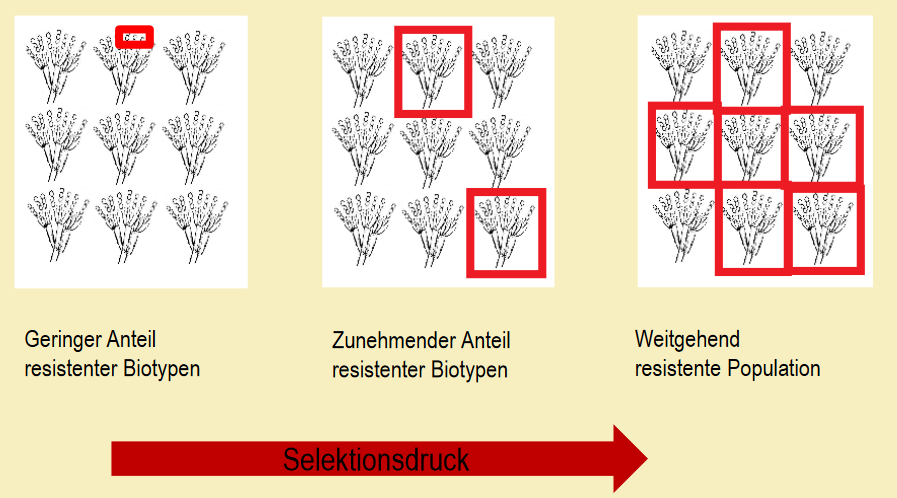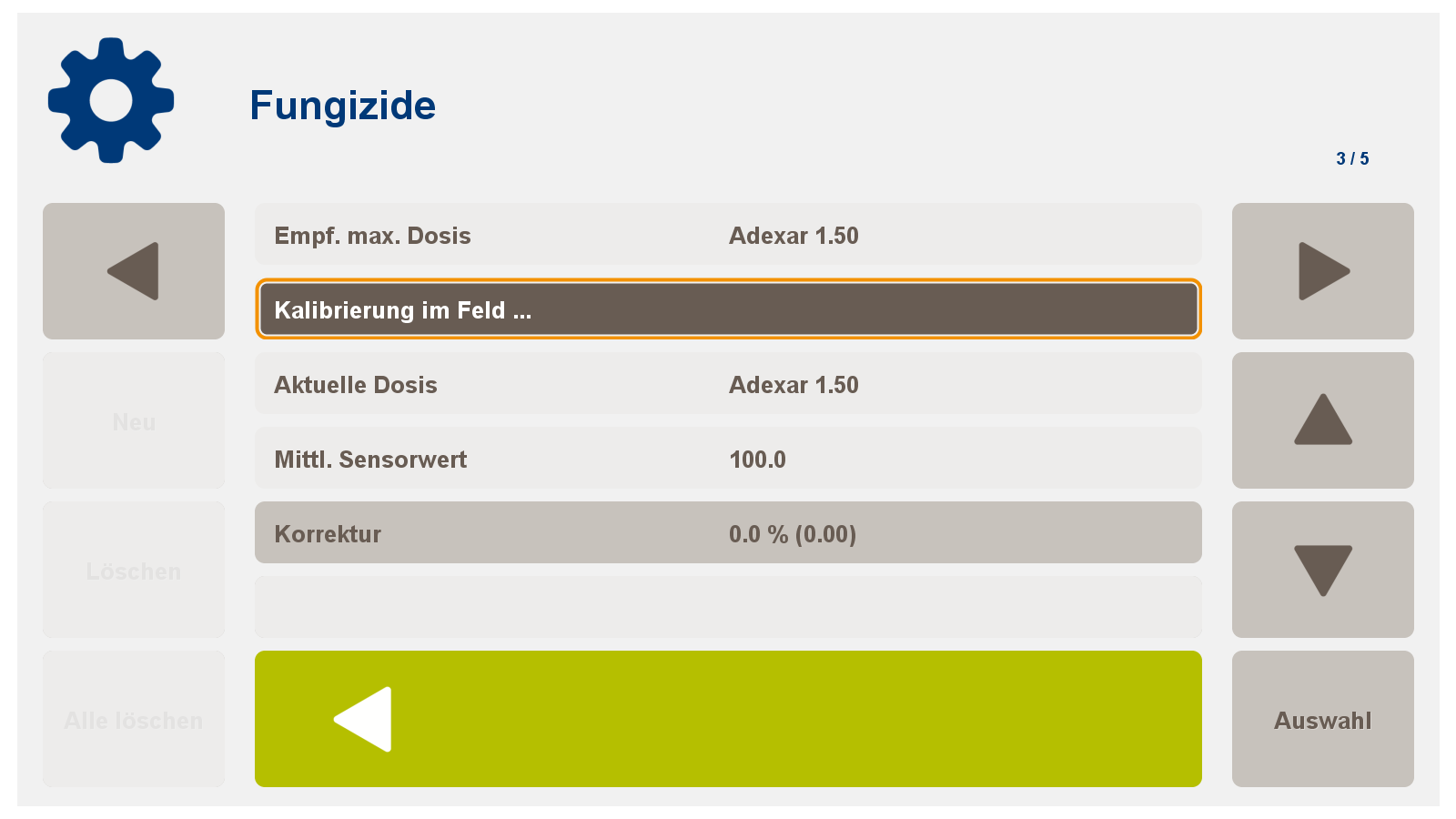Resistenzmanagement
Eine Resistenz im Pflanzenschutz ist die Fähigkeit von Organismen, im speziellen Schaderregern, die Anwendung von Pflanzenschutzmitteln zu überleben. Dabei werden zwei wesentliche Resistenztypen unterschieden.
Resistenztypen
Metabolische Resistenz (quantitative Resistenz oder "Shifting")
verminderte Wirkstoffaufnahme und -transport
verstärkter enzymatischer Abbau (Septoria tritici)
verminderte Intensität der Wirkstoffaktivierung im Zielorganismus
Vermehrung des Wirkorts (Kompensation durch Wirkminderung an vielen Orten)
Target-Site-Resistenz (qualitative Resistenz)
genetische Punktmutation im Schaderreger sorgt für ein komplettes Ausbleiben der Wirkung des Pflanzenschutzmittels (z.B. Mehltau- und Septoria tritici-Resistenz gegen Strobilurine)
Ursachen
- Erhöhter Selektionsdruck durch den wiederholten Einsatz von Pflanzenschutzmitteln mit gleichen Wirkstoffen und Wirkmechanismen in der gleichen Erregerpopulation

Selektivität = Wirksamkeit bestimmter Pflanzenschutzmittel rein auf den Schaderreger oder nur einen bis wenige Wirkorte in der Kulturpflanze
durch immer stärker wachsende Anforderungen des Umwelt- und Verbraucherschutzes werden die Wirkspektren bei der Herstellung von Pflanzenschutzmitteln immer enger, was zur Folge hat:
→ erhöhte Resistenzentwicklung gegenüber Pflanzenschutzmitteln, da schon eine Veränderung des Schaderregers, durch natürliche Genmutation am Wirkort, zur Resistenzbildung führt
Der Selektionsdruck wird durch drei Faktoren maßgeblich bestimmt:
Anwendungshäufigkeit
Wirkstoffdosis
Resistenztyp bestimmen den Selektionsdruck, sowie die -geschwindigkeit
Eine Resistenz im Pflanzenschutz ist die Fähigkeit von Organismen, im speziellen Schaderregern, die Anwendung von Pflanzenschutzmitteln zu überleben. Dabei werden zwei wesentliche Resistenztypen unterschieden.
Resistenzvermeidung
Wenn der Einsatz von Pflanzenschutzmitteln nötig ist, gibt es 2 wesentliche Prinzipien, die berücksichtigt werden müssen:
Wechsel des Wirkstoffes für die Folgespritzung und vor allem Wechsel der Wirkstoffgruppe (bei Fungiziden besonders betreffend: Azole, Carboxamide und Strobilurine)
Die optimale Dosierung des Pflanzenschutzmittels, bezogen auf den Pflanzenbestand und Vermeidung einer Über- und Unterdosierung!
→ Durch eine Applikation mit dem Pflanzenschutzverfahren kann die Dosierung im Feld genau geregelt und automatisch an den Pflanzenbestand angepasst werden
Positive Wirkung des Einsatzes von Pflanzenschutzsensoren auf das Resistenzmanagement
Verminderung des "Shiftings" (quantitative Resistenz) durch Vermeidung von Unterdosierung, aufgrund von ständiger Ermittlung der Biomasse und der damit tatsächlich benötigten Applikationsmenge. Durch die Empfehlung der maximalen Dosis im Softwareprogramm der pf Box (auf Grundlage des Expertensystems von Bayer, ehemals proPlant) wird einer Überdosierung schon von Anfang an vorgebeugt und die Näherung zur optimalen Menge durch die Kopplung mit dem Sensor noch weiter optimiert.

Eine Unterdosierung wird durch den Sensoreinsatz weitestgehend optimiert und der quantitativen Resistenz damit enorm vorgebeugt
Die Überdosierung im Bestand wird durch die gegebene Empfehlung in Kombination mit dem Sensor verhindert und die Entstehung von Punktmutationen (qualitative Resistenz) durch einen deutlich erhöhten Selektionsdruck vermieden
Fazit
Ein Resistenzmanagement im Pflanzenschutz ist unerlässlich und mit einer Verbesserung des Erreichens der optimal nötigen Mittelmenge wird der Resistenzbildung aktiv entgegengewirkt und in Kombination mit ständigem Wirkstoff- und Wirkstoffgruppenwechsel ein gutes Anti-Resistenzmanagement in Ihrem Unternehmen aufgebaut.
Resistance in crop protection is the ability of organisms, in particular pests, to survive the use of crop protection products. There are two main types of resistance.
Types of resistance
Metabolic resistance (quantitative resistance or "shifting")
reduced absorption and transport of active substances
Enhanced enzymatic degradation (Septoria tritici)
reduced intensity of active ingredient activation in the target organism
Increase in the site of action (compensation by reduced effectiveness in many places)
Target site resistance (qualitative resistance)
Genetic point mutation in the pathogen ensures that the pesticide does not work completely (e.g. mildew and Septoria tritici resistance to strobilurins)
causes
- Increased selection pressure due to the repeated use of pesticides with the same active ingredients and mechanisms of action in the same pathogen population

Selectivity = effectiveness of certain plant protection products only on the pathogen or only one or a few active sites in the crop
As the requirements of environmental and consumer protection continue to grow, the spectrum of action in the manufacture of crop protection products is becoming ever narrower, which has the consequence:
→ Increased development of resistance to pesticides, since a change in the pathogen through natural gene mutation at the site of action leads to the development of resistance
The selection pressure is largely determined by three factors:
Frequency of use
Drug dose
Resistance type determine the selection pressure and the speed
Avoidance of resistance
If the use of crop protection products is necessary, there are 2 main principles that must be taken into account:
Change of the active ingredient for the subsequent spraying and above all change of the active ingredient group (especially with regard to fungicides: azoles, carboxamides and strobilurins)
The optimal dosage of the plant protection product, based on the crop and Avoiding overdosing and underdosing!
→ With an application using the crop protection method, the dosage in the field can be precisely regulated and automatically adapted to the crop
The positive effect of the use of crop protection sensors on resistance management
Reduction of "shifting" (quantitative resistance) by avoiding underdosing, due to constant determination of the biomass and the amount of application actually required. By recommending the maximum dose in the pf Box software program (based on the expert system from Bayer, formerly proPlant), overdosing is prevented right from the start and the approximation to the optimal amount is further optimized by coupling with the sensor.

Underdosing is largely optimized through the use of sensors, thus preventing quantitative resistance enormously
The overdosing in the herd is prevented by the given recommendation in combination with the sensor and the occurrence of point mutations (qualitative resistance) by a significantly increased selection pressure is avoided
Conclusion
Resistance management in crop protection is essential and with an improvement in reaching the optimally necessary amount of resistance, the development of resistance is actively counteracted and, in combination with constant change of active ingredient and active ingredient group, a good anti-resistance management is built up in your company.
